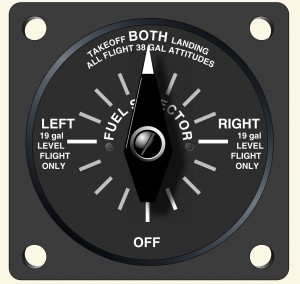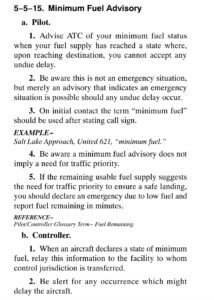 Pilots are hesitant to declare an emergency and even more hesitant to tell Air Traffic Control (ATC) if they have a possible problem. The reasons are many fold but the justification I hear often is they don’t want to deal with the paperwork. This is not a good excuse, especially when not advising ATC of your fuel situation could lead to a fuel emergency.
Pilots are hesitant to declare an emergency and even more hesitant to tell Air Traffic Control (ATC) if they have a possible problem. The reasons are many fold but the justification I hear often is they don’t want to deal with the paperwork. This is not a good excuse, especially when not advising ATC of your fuel situation could lead to a fuel emergency.
If you have any problem or are experiencing a condition that would jeopardize the safety of the flight you should immediately let ATC know so they can begin assisting you. If your engine quits you would let ATC know right away, so why not do the same when your fuel begins getting low.
A minimum fuel situation allows the pilot to continue for a long time before the engine quits and is one of the reasons some pilots tend not to take immediate action by notifying ATC or proceeding to an alternate airport. The wonderful aspect when declaring minimum fuel is that it is an advisory to ATC and requires no paper work.
What is Minimum Fuel?
 Minimum Fuel is “when your fuel supply has reached a state where upon reaching your destination you cannot accept any undue delay”. Minimum fuel is not a need for priority and is only an advisory to ATC. If you need priority because you are low on fuel then you should declare an emergency and let ATC know how much fuel in minutes you have on board.
Minimum Fuel is “when your fuel supply has reached a state where upon reaching your destination you cannot accept any undue delay”. Minimum fuel is not a need for priority and is only an advisory to ATC. If you need priority because you are low on fuel then you should declare an emergency and let ATC know how much fuel in minutes you have on board.
Since we are flying IFR we will need to have enough fuel per FAR 91.167 to fly to the destination, the alternate, and have an additional forty-five minutes of fuel. Since the FAA is vague on when we should declare minimum fuel most commercial operators have rules and many individuals have guidelines as to when to declare minimum fuel.
Most airline operations manuals provide guidance requiring pilots to declare minimum fuel if the crew will have only 45 minutes of fuel on board when they land. I personally use this as my minimum when I declare minimum fuel. Some of you may consider using one hour as your minimum fuel advisory. Whatever you decide I suggest you take a very conservative approach and declare minimum fuel early instead of too late.
So when do we declare minimum fuel when an alternate has been filed? If you spend much of your time flying into busy airspace such as New York, you know that you might suddenly be placed into a hold for a long time. The most important thing to do in this situation is to have a plan and execute that plan when you find yourself holding and the fuel running low.
If you have an alternate and cannot be delayed any longer don't be shy, let Air Traffic Control know as soon as possible so they can start planning accordingly. When you call the controller let them know that you can only hold or be delayed for a specific number of minutes and if a longer delay is necessary you will need to divert for fuel.
When an alternate has been filed in your flight plan you normally would not declare minimum fuel but you need to let ATC know how much longer you can hold before you need to divert to an airport for fuel. If you do not declare minimum fuel or let ATC know about your low fuel state, they will never know you have a problem. ATC is an important resource we have available so use them as soon as you know you need assistance.
Example. Minimum Fuel Without An Alternate:
Flying from Wilkes-Barre, Pennsylvania (KAVP) to Teterboro, New Jersey (TEB) we file IFR but do not have an alternate because the weather is 3000 overcast and 10 miles visibility. On our way towards TEB we are given a clearance to hold at Stillwater VOR as published with an Expect Further Clearance Time (EFC) in one hour. We have two hours of fuel on board so we start holding and making calculations on our fuel. You determine the flight from Stillwater to TEB is fifteen minutes which means we must leave Stillwater with at least one hour of fuel to have our forty-five minute reserve when we land.
After one hour holding the controller begins vectoring us towards TEB. Since we now only have one hour of fuel we call the controller and declare minimum fuel. They answer with Roger and continue to vector you. Passing overhead Morristown the controller issues the clearance “fly direct Stillwater VOR expect further holding”. You tell the controller you will need to divert to get some more fuel and tell them you will be proceeding to Morristown, NJ (MMU). At first you might get frustrated with the controller in this situation. Declaring minimum fuel does not give you priority it is simply a notification to the controller of a fuel state which will will require no undue delay.
Example. Minimum Fuel With An Alternate:
Let's use the same example above but in this case the weather at Teterboro is one thousand overcast therefore we file an alternate of Morristown. On the way to Teterboro the controller gives you a hold for one hour and you have two hours of fuel on board when you enter the hold. You calculate that it will take fifteen minutes to fly from Teterboro to Morristown so the minimum amount of fuel you want to land with in Teterboro is one hour of fuel.
After holding for an hour the controller gives you additional holding for thirty minutes. You cannot hold for that long so instead of declaring minimum fuel you tell the controller that you will need to proceed to your alternate because you don't have enough fuel to hold. The controller advises you there is a disabled aircraft in Teterboro and asks your intentions. You then call the controller back and tell them you are proceeding to your alternate of Morristown. In this case we never used the term minimum fuel but we did tell the controller of our fuel situation.
Conclusion:
Minimum fuel is an advisory to ATC that your fuel supply has reached a state where upon reaching your destination, you cannot accept any undue delay. This is a vague statement which many commercial operators have clarified in their operations manuals to give guidance as to when to declare minimum fuel.
Since we must have forty-five minutes of fuel available when we land while operating under IFR, I suggest you use at least forty five minutes of fuel remaining in your tanks when you declare minimum fuel. Most pilots I know use the one hour rule and declare minimum fuel when they will land with only an hour of fuel in the tanks.
Whatever you do remember to be safe and conservative when it comes to the amount of fuel you are carrying. Also, make sure you always have a contingency plan which includes a fuel stop in case something happens and your destination closes. During my flight I always have an idea where I will land if I need more fuel. I suggest you do the same.
Safe Flying!

Comments on this entry are closed.